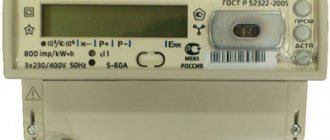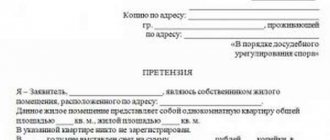It is necessary to transmit the data of an individual meter within a certain period of time. This ensures payment is calculated according to current tariffs. But in order to avoid discrepancies and errors, you need to correctly take the electricity meter readings. In fact, there is nothing complicated here, although not everyone knows where to look and which button to press to rewrite the necessary information.
What methods of transmitting evidence are there?
You can submit your testimony in any way convenient for you:
- through the Personal Account of a private client on the website of PJSC Mosenergosbyt;
- by phone Contact: +7 (499) 550-9-550 via voice control service;
- on the Moscow government services portal.
- through terminals for receiving readings installed in the branches of PJSC Mosenergosbyt and Multifunctional centers for providing state and municipal services;
- when paying through Qiwi and Sberbank terminals (subject to payment being made between the 15th and 26th).
How to use the Voice Control service?
When you contact the Contact Center by phone +7 (499) 550-9-550, you can independently, without waiting for an operator’s response, transfer meter readings or obtain the necessary information. To do this, in the voice menu after the question “Tell me what interests you?” you need to say your question.
You can read the instructions for operating the voice service on the website of PJSC Mosenergosbyt.
Attention!
The personal account number and meter readings must be given strictly in one digit. You can enter data using the telephone keys. To undergo automatic identification, we recommend linking your phone number to your Personal Account in the Client’s Personal Account.
How is energy measured?
Translated from Greek, energy means activity, force, action. It is a scalar quantity and measures all kinds of motion and interconnections of matter. Energy is denoted by the letter E. The units of measurement for this quantity are: in the SI system - joule (J), in the GHS system - erg.
Electrical energy consumed by electrical appliances is calculated by meters. They provide numerical readings of power consumption (kW) per kWh.
The Relationship Between Strength and Energy
A connection has been established between the conservative force, which causes the potential energy of all interacting bodies, and this energy.
For your information. Conservative forces are those forces that do work to move a point. In this case, the work is determined by the extreme positions of this point: initial and final.
Conservative forces include the following forces:
- heaviness;
- elasticity;
- Coulomb forces.
If you close the trajectory of a point under the action of conservative forces, it will be equal to zero.
You can trace the connection using the following algorithm:
- When at any point in space a body is subject to the action of a conservative force, it means that it is located in a potential field.
- A change in the position of a body within a field causes a change in potential energy, in which a conservative force does work.
This work can be expressed mathematically. For example, the body moved in a random direction r, deviating from the initial position by a very small distance dr. This means that dA = F*dr*cosα = Fr, dr, where F = F* cosα is the projection of the force onto the direction r.
There is an equality: dA = – dEп, where Ep is potential energy. So, putting an equal sign between the two expressions, it turns out:
Fr *dr = – dEп, from which Fr = – dEп/dr is expressed.
The ratio dEп/dr is a quantity showing the rate of change of potential energy along a given direction; it is the derivative of Ep in the r direction.
Attention! The minus sign means a decrease in potential energy in the direction dr. The partial derivative symbol indicates that the differentiation of potential energy Ep (x, y, z) occurs only with the argument x, with the other two unchanged
Relationship between potential energy and force
Power and energy
Power P is the work done per unit of time. The unit of power is watt (W). To find out how many watts are 1 kW, you need to remember that “kilo” is 103. Therefore, 1 kW = 103 W, and 10 kW = 104 W.
Typically, the power of electrical receivers is measured in kilowatts. Applicable to technology, there is also a measurement of power in horsepower (hp). One such horsepower is equal to 736 watts.
Power and horsepower
The ability of a certain body or an entire system to perform work is characterized by its energy. Energy unites in its concept all events in nature. Different types of movement are characterized by different types of energy.
Advice. Mechanical energy related to the movement of a body is called kinetic, associated with the mutual position of bodies (body parts) of the system - potential.
Mechanical energy
Calories and joules
Before you figure out how to convert (convert) calories to joules and vice versa, you need to know what these two concepts mean.
The joule is a unit used to measure work, energy, or heat. In the international SI system, the joule is denoted by J (J). The work done by a force of one newton (1N) to move a point in the direction of application of the force one meter (1m) is equal to one joule (1 J).
Calorie is a quantity not separately reflected in measurement systems, used to determine the amount of heat. To heat 1 g of water by 1 C0, you need to spend energy equal to 1 calorie (cal). In this case, 1 cal = 4.1868 J.
Communication with other units
You can use an online calculator to express calories in joules and back.
The program interface allows you to enter the values of the required quantities (using abbreviations of multiple values). When you don’t have the Internet at hand, it’s easy to make a translation by making a proportion. For example, you need to find out how many kilocalories are in 100 kJ. To do this, make up the proportion:
- 1 kcal = 4.1868 kJ;
- X = 100 kJ.
Solving the proportion, we get the expression X = 100 * 1/4.1868 = 23.9 kCal. The answer is that 100 kJ contains 23.9 kcal.
How are electricity bills calculated?
The amount payable is calculated in one of the following ways:
- Based on the meter readings you provided; Provided that the meter readings were transmitted in the period from the 15th to the 26th inclusive
- Based on meter readings taken by employees of Mosenergosbyt PJSC; Control readings are taken by an employee of Mosenergosbyt PJSC 2 times a year.
- If there are no readings in the billing period, the amount payable is calculated based on the average monthly consumption volume;
- In the absence of information on the average monthly consumption volume, the calculation is made based on the consumption standard.
Energy-saving lamps
Belarusians are still not particularly active in purchasing energy-saving lamps. “People buy incomparably more incandescent lamps,” Anatoly Zelev, head of the purchasing department of this company, looks at the sales statistics of Oma LLC, which has 7 construction buildings in Belarus. “We attribute this to the fact that our tariffs are still low, and energy-saving lamps are expensive - the payback period is long. For a person to immediately shell out 300 thousand to buy ten light bulbs is expensive. But we must take into account that later there will be significant savings on electricity.” Although, recently, the specialist notes, energy-saving lamps are being purchased more actively. People began to show interest three years ago, and it is growing. Anatoly Zelev himself replaced all the lamps in the apartment with energy-saving ones two years ago. “This allowed me to reduce electrical energy consumption by 1.5 times.” From September 1, 2012, the production and sale of incandescent lamps is completely prohibited in the European Union. Very soon they will completely disappear from the lives of Europeans. Since last year, restrictions on the circulation of incandescent lamps have been introduced in Russia - it is forbidden to produce, import and sell incandescent lamps with a power of 100 W or more, and also to buy any incandescent lamps for government needs.
We have no plans to introduce such bans, says Zhanna Zenkevich: “How can we prohibit our pensioner from buying a cheap light bulb instead of an expensive one?” Yes, in the store today a cheap energy-saving one costs about 30 thousand rubles, and a regular incandescent one costs 3,800 rubles.
What is ODN and how is it calculated?
ODN - general house needs. Each apartment building receives a certain amount of utility resources, the bulk of which is consumed by residents. Some of the resources go to maintaining the house and maintaining common property. Not only utilities inside the apartment are paid, but also utilities used for general house needs.
The amount of one tax charge for electricity may include costs for:
- Lighting of common areas (staircases, vestibules and entrance areas);
- Energy consumed by intercoms;
- Energy consumed by elevators;
- Energy consumed by other electrical equipment; Used for general house needs (for example, surveillance cameras, pumps pumping water to the upper floors, automatic heat control system, etc.).
Each apartment building has an individual set of electrical equipment. Calculation of the consumed electricity at the ODN is carried out in accordance with the Decree of the Government of the Russian Federation No. 354 dated May 6, 2011, P.44:
- Based on the readings of collective metering devices; The expense for one-room registration is determined as the difference between the expense of a certain collective metering device and the total consumption of residential and non-residential premises, then divided by the total area of such premises, and then multiplied by the individual area of each of them.
- In the absence of a common house meter, the calculation is made according to the standard. If the electricity consumption for ODN is determined based on the ODN standard, then the value obtained by multiplying the standard by ODN and the area of the premises included in the common property in an apartment building is divided by the total area of the premises, and then multiplied by the individual area of each of them .
From joule to kilowatt
Since 1 kW is one thousand watts, the relationship between these two system quantities is considered initially based on one watt.
Joule concept
When applied to an electrical circuit, 1 J is equal to the work that electric field forces do in 1 second (s) to maintain a current of 1 ampere (A) at a voltage of 1 volt (V). In other words, 1 kJ = 1 kWh.
Converting joules to kilowatt hours
To convert a known number of joules into kilowatt-hours, this is done by direct and reverse conversion of mechanical and electrical energy. This is necessary when performing calculations of the performance of electrical machines: engines and generators.
Important! For calculations, the well-known relation 1 MJ = 0.277(7) kW⋅h is used, from which it follows that 1 kW⋅h = 3.6 MJ. Mega is 1*106
For example, you need to convert 15 MJ to kWh. To do this, multiply 15 by 0.277:
15*0.277 = 4.15 kWh.
If you need to determine how many joules are 15 kWh, calculate as follows:
15*3.6 = 54 MJ = 54000 kJ = 54*106 J.
The fairness of such calculations is based on the fact that the implementation of the transition to another measurement system was carried out taking into account time. One hour in minutes is equal to 60 minutes. A minute, in turn, consists of 60 seconds, and there are 3600 of them in one hour. One kilowatt contains 1000 watts. Multiplying the number of watts by the number of seconds gives the size of one joule - 3.6 million (MJ). Recording energy consumption in kilowatts for billing calculations has made it easier to evaluate meter readings.
Changing the dimension of power units
You can often come across questions related to the dimension of P units. The most common questions are:
- what is a kilowatt?
- how many kWh in kW;
- how much is 1kW equal to watt;
- 1 kW is how much watt or quat is it;
- how many watts are in 1 kW;
- what is the number of kilowatts per kilowatt hour?
Despite all the variations of letter abbreviations, everything is simple. A kilo is a thousand, so 1 kW is equal to 1000 watts (W). This is also true for volts - 1 kilovolt (kV) is equal to 1000 volts. One thousand kilowatts is equal to 1 megawatt (MW). The multiplicity of units helps to clearly determine the ranks of power values P.
Using these data, it is convenient to plan your family budget. By multiplying the power consumed by the device by the amount of time it is in use, you can estimate its daily consumption. Multiplying the daily load by the number of calendar days in a month allows you to accurately estimate the energy consumption of the entire home.
Power unit multiplicity table
Why does the electricity consumption for the single-circuit heating unit change monthly and how can we achieve a reduction in the amount for the single-unit heating unit?
The amount of electricity consumption for one unit is calculated and depends on several factors and may change every month.
The cost of ODN depends on factors such as:
- Intensity of operation of electrical equipment installed on the ODN;
- Regularity of transmission by residents of the house of individual readings of metering devices to PJSC Mosenergosbyt (if the readings are not transmitted, then the calculation is formed based on the calculated average monthly volume of consumption, and when transmitting or taking readings in the subsequent billing period, the volume of consumption will be recalculated based on actual data);
- Absence of unaccounted and/or non-contractual consumption;
- Technical condition of intra-house wiring (electrical wiring in old houses may be worn out and this increases technological losses of electricity in intra-house networks);
- Equipping residential premises with working metering devices.
Retrieving information and calculations for different models
Although the operating principle of modern IPUs is almost identical, depending on the variety there may be some differences:
- "Mercury 200". The “Enter” button is pressed, after which the time, date, readings by zone and total flow appear. The letter designation of the tariff is in the upper left corner. According to the described calculation example for a specific territory, the total payment amount is calculated.
- "Energymera". The most common are two- and multi-tariff modifications. Readings from this meter are taken according to a scheme similar to the previous option. The main difference is that you need to press the "PRSM" button.
- "Micron". It is not difficult to take readings from such a meter, provided that certain nuances are observed. At the bottom left side of the case there is a button, when pressed, the necessary information is displayed. A special feature of the device is that the designations of tariff zones T1, T2 or T3 do not appear; they are already signed at the bottom of the screen and highlighted with a tick. The payment amount is calculated according to the standard scheme.
- Saivan. The most economical option that is popular. It differs from others in the absence of a button that highlights specific values and shows data sequentially with a small interval. The necessary parameters are recorded and checked, for which it is necessary to let the counter go around in a circle. The calculation depends on the modification of the electricity meter and the current tariff.
Advice! To eliminate errors when taking readings, you must first familiarize yourself with the product data sheet, which contains the correct algorithm of actions.
When choosing an electric meter, it is advisable to give preference to domestic models or meters manufactured in the CIS, since imported options may not be adapted to our networks











